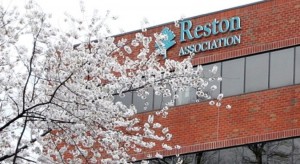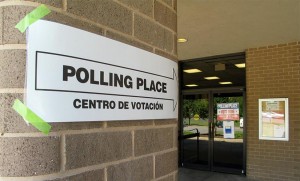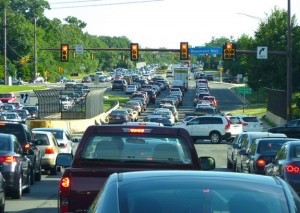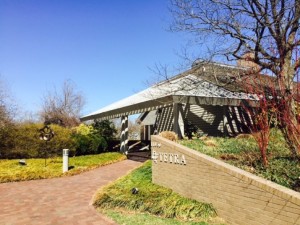This op-ed was submitted by Lynne Mulston, vice president of Reston Citizens Association, chair of Rescue Reston’s North Course Committee, and a member of Hidden Creek Country Club. It does not reflect the opinions of Reston Now. We publish article and opinion contributions of specific interest to the Reston community. Contributions may be edited for length or content.
What doesn’t Wheelock understand about the Reston community’s response to their plans to develop Hidden Creek Country Club?
The focus groups that were held last year should have sent a clear message that the majority of the participants want the open space golf course at Hidden Creek to remain as such. One focus group participant said, “You [Wheelock and Swaback] don’t get it. We already have our park and we don’t pay a cent for it.”
The members of Hidden Creek — many of whom are long-term residents of Reston, have chosen to raise their families here, paid their taxes to Fairfax County including the added Small Tax District #5 assessments for the pleasure of living here, joined Hidden Creek for its amenities including swimming, tennis and golf, a sport that you can play well into your retirement years. In fact, there are numerous senior members (70+ years of age) at the Club which also serves as the home course for McLean High School’s golf team.
I was shocked recently when I received photos of a display that Wheelock Communities has set-up in a member event room just off the Tavern Bar and Grill. Every inch of wall space is covered with posters, presentations, and pictures of the plunder of Wheelock’s vision to turn 164-acres of open space that Gulf Reston originally dedicated to the people of Reston.
Here are just a few of the details of Wheelock’s proposal for HCCC’s development:
- 100+ acres and 8-10 tennis courts would be dedicated to Fairfax County Park Authority. That’s right! The open space that the Reston community pays NOTHING to maintain, would go the FCPA which our tax dollars fund. IOW, Restonians would now be tasked to pay so that Wheelock can make a profit by further densifying Reston despite that fact that the Reston Master Plan has always said both Reston golf courses shall remain open space!
- Reston was originally planned with two permanent 18-hole golf courses to offset significant overall community density elsewhere. Now Wheelock wants to reduce the cumulative open space requirements by developing choice portions of the course. 650 homes would be placed on the open space that Robert Simon envisioned. Vehicular traffic on a proposed new road system would significantly add to the congestion we’re already experiencing. Our already overcrowded schools would be further stressed.
- Fairfax County is planning to build a new 4-acre storm water management pond on the southern portion of HCCC to fix past development mistakes which result in flooding north of the Dulles Toll Road. Pursuant to this plan and Wheelock’s inability to develop land in this area due to it being a pipeline and floodplain, plans are to convert a huge part of the present course to other recreational amenities managed by the FCPA. The issue is if this is allowed, we taxpayers will pay in perpetuity for what now is ecologically precious open space.
- Wheelock is promoting a false narrative that when golf course use is eliminated, draining water from Lake Anne will cease. Claims that Hidden Creek takes 150,000 gallons of water per day from Lake Anne are erroneous. At first glance, this sounds like a lot of water but let’s look at the FACTS:
- The lake covers 27.7653 surface acres with an average depth of 13 feet. This means that the volume of the lake is 117,615,560 gallons.
- Hidden Creek monitors the pond near Temporary Road and North Shore Drive regularly. Only when needed does Hidden Creek draw water from Lake Anne.
- At maximum capacity, Hidden Creek’s pump can only pump 179 gpm. They rarely use it at that rate, but if they did, it would take 2.5 days to draw down the lake 1-inch.
It’s clear that Wheelock is betting their $14 million investment could net a return of $250 million; their investors are relying on their success. It’s up to us to show them why Reston was a poor choice for their exploitations. Vote for candidates who clearly state their intent to protect Reston’s golf courses. Save our community!
Photo via Lynne Mulston
 This is an op-ed submitted by George Mason University student Jalen Stubblefield. It does not reflect the opinion of Reston Now.
This is an op-ed submitted by George Mason University student Jalen Stubblefield. It does not reflect the opinion of Reston Now.
I grew up in Alexandria, VA and have lived here the vast majority of my life. I graduated from Edison High School in 2012, and will graduate from George Mason University this December. I am a Democrat and I oppose the Fairfax County Meals Tax. Here is why.
First and foremost, I understand that enrollment in schools has risen, and that teachers are severely underpaid. I understand the important role public education plays in America, ensuring that every child that works hard has the opportunity to succeed. What I do not understand is a Meals Tax.
Attending school at Edison, I had a number of friends that were growing up without parents in their household. No, the parents had not left them. They were working from early in the morning, sometimes before school started, to late at night, sometimes long after their children had slept.
Take my friend, we’ll call him Josh, his parents would drop him off long before school began, and he would walk home in the afternoon because his parents were working. For food, he was on the free-and-reduced meals program, and his parents would give him $5 for dinner since there was no time for them to cook during the week.
Josh’s story is typical. According to a report by the Commonwealth Institute, 8 percent of school-age children are growing up in poverty and 28 percent are on the free-and-reduced meals program. Read More
 This is an op-ed from Reston resident Lynda Reyes. It does not reflect the opinion of Reston Now.
This is an op-ed from Reston resident Lynda Reyes. It does not reflect the opinion of Reston Now.
I am writing in support of the Meals Tax. My parents risked their lives to come to this country. They had nothing when they arrived, but they worked long hours at low wages to provide my family with opportunities that are not available in other countries. We made Fairfax County our home, but because of the rhetoric surrounding the Meals Tax, we do not feel welcome here anymore.
In conversations and online comments, there is a consistent emphasis on the burden imposed by kids who are not white and wealthy. One commenter on FCPS School Board member Pat Hynes’ recent op-ed stated that “the outputs of English language learners, special education students, emotionally challenged students, and less financially advantaged students is incommensurate with the financial input” — in other words, it is supposedly a waste of money to educate immigrant kids, kids with special needs, and poor kids. Read More
This is an op-ed by Tony Shivers, Vice President of Advocacy for the
Fairfax County Council of PTAs (FCCPTA). It does not reflect the opinion of Reston Now.
 As Vice President of Advocacy of the Fairfax County Council of PTAs, I urge my fellow parents, residents, and business owners to vote YES for the non-partisan meals tax on Nov. 8.
As Vice President of Advocacy of the Fairfax County Council of PTAs, I urge my fellow parents, residents, and business owners to vote YES for the non-partisan meals tax on Nov. 8.
For just a few pennies more:
- A 4-percent tax on prepared meals will generate $100 million for schools and county services, with $28 million being paid by tourists and visitors to Fairfax;
- FCPS will receive 70 percent of those revenues to help stem the loss of our best teachers and address classroom size;
- County services will receive 30 percent of net revenues to address unmet public safety needs and those of our libraries and parks;
- Fairfax County can diversify its tax base and relieve property tax pressure on homeowners while maintaining its AAA bond rating; and capture revenue from travelers and non-resident workers that utilize County programs and services.
Why a meals tax, rather than a tax on cigarettes or alcohol? The answer is simple. Virginia state law strictly limits the taxing authority of its counties — a meals tax is the only option at this level of government.
Why not pursue state funding? The short answer is that our children will be grown by the time state funding is brought to an appropriate level for Fairfax County. The state continues to push more of the cost of K-12 education back to localities. Fairfax County estimates that the shortfall in state funding for K-12 education has climbed to more than $1 billion annually since 2009.
In fact, the reliability of the state money promised to education is now in question. Virginia Gov. Terry McAuliffe recently advised the state legislature that that Commonwealth may experience as much as a $1.5 billion revenue shortfall in its two-year budget.
Historically, PTA is an advocacy organization, and the efforts of parents have resulted in immunizations, school lunches, child labor laws, among other accomplishments. PTAs do not promote candidates for election, but they do promote issues which benefit children.
Virginia PTA supports any meals tax where 50 percent of the revenue goes to public schools. Here in Fairfax the proposed meals tax would do far more.
The PTA’s motto is “Every Child. One Voice.” All Fairfax County children need the best education our community can deliver. Parents, please vote yes for your children. Vote yes for the meals tax.
Tony Shivers
Vice President of Advocacy
Herndon, VA
 This is an Op-Ed from Pat Hynes, Fairfax County Public School Board’s Hunter Mill representative, about the Meals Tax referendum that will put to county voters on Nov. 8. It does not reflect the opinion of Reston Now.
This is an Op-Ed from Pat Hynes, Fairfax County Public School Board’s Hunter Mill representative, about the Meals Tax referendum that will put to county voters on Nov. 8. It does not reflect the opinion of Reston Now.
If you had told me, when I was running for school board five years ago, that I would spend so much time talking about money and taxes, I might have been a little discouraged. But advocating for revenue is part of the job — the people of this community expect excellent schools with world-class curricular and extracurricular programs, and we’re smart enough to know that you get what you pay for in this life.
I learned early on that school funding in Virginia has some serious structural challenges — we send at least three times as much revenue down to Richmond as we get back for our schools and other critical public services. And then Richmond ties our hands when it comes to raising revenue locally for local needs.
A meals tax is one of very few options available to local governments, which is why two-thirds of Virginia counties — and most towns and cities — have adopted a meals tax to help balance their reliance on property taxes.
Local revenue since 2008 has not kept pace with growing population and rising costs. That is certainly true for the school system. Between 2008 and 2015, the gap between revenue and needs was so wide that by fiscal year 2015 the school system was spending $1000 less per child — in real dollars — than in 2008. We got there by freezing teacher pay and raising class sizes several times, and annual cuts to central office. Read More
 This is an op-ed by Reston resident Ed Abbott. It does not reflect the opinion of Reston Now.
This is an op-ed by Reston resident Ed Abbott. It does not reflect the opinion of Reston Now.
During the regularly scheduled Reston Association Board meeting on Sept. 22, RA CEO Cate Fulkerson presented items for the board to consider as they prepare RA’s 2017 “draft” budget. According to the presentation, members’ annual assessments may increase from $657 to $712 next year.
There are numerous problems with this, the least of which is the assessment increase. Let’s take these one at a time.
There is no such thing as a “draft budget” in the second year of a biennial budget. The board passed the 2017 budget in November 2015. Once the Board approves the biennial budget, the budget is final. By creating a 2017 draft budget at this stage, the budget process is morphing into an annual budget review and approval process in clear violation of the governing documents, which specify a biennial budget process.
Budget information is not presented to the Board in an organized and intelligible manner. The latest budget presentation by CEO Cate Fulkerson and Board Treasurer Danielle LaRosa is a good example. It starts out well with a “Back to Basics” slide that should tie the budget items back to RA’s mission statement, but this never happens. Instead, the presentation includes a confusing and incoherent array of tables and graphs. Read More
 This is an op-ed by Pat Hynes, Fairfax County Public Schools Board member representing the Hunter Mill District. She is speaking for herself and not the entire school board in this post, which also does not represent the opinion of Reston Now.
This is an op-ed by Pat Hynes, Fairfax County Public Schools Board member representing the Hunter Mill District. She is speaking for herself and not the entire school board in this post, which also does not represent the opinion of Reston Now.
If you’ve ever participated in a “Dining for Dollars” event for your local school, you know how important the relationships between school PTAs and neighborhood restaurants are.
That’s why when the Fairfax County Board of Supervisors recently voted to put a meals tax referendum on the November ballot, they were careful to signal that some of the revenue — about $3 million annually — would go back to restaurants to pay the costs of collecting the tax. As we diversify and stabilize our community’s revenue base for important needs like the school system, local businesses must be supported as well.
Counties in Virginia have very little flexibility or authority when it comes to generating revenue, and a meals tax is one of those few options. Read More
 This is an op-ed by Tom Krasselt, formerly of RestonDogs, the nonprofit that administered the dog park at Baron Cameron Park. It does not represent the opinion of Reston Now.
This is an op-ed by Tom Krasselt, formerly of RestonDogs, the nonprofit that administered the dog park at Baron Cameron Park. It does not represent the opinion of Reston Now.
I used to lead the RestonDogs organization and don’t usually make posts about issues related to the dog park in public forums. However I felt like I needed to provide a few comments about the Reston Association (RA) recommendations for Fairfax County Park Authority (FCPA) about the Reston Dog Park or Reston Off Leash Dog Area (OLDA).
First of all, the decision on the location of the Reston Dog Park has already been litigated and decided by the court system, the case was dismissed without being heard; the case was very weak on any factual data.
The primary question I have is why is the RA taking this on as an issue. Do they feel some urgent need to tell FCPA how to do their job and does RA have a specialty in noise, or park/dog park management? With few exceptions, dog park users are extremely happy with the support we get from FCPA. Let’s not make FCPA the problem, FCPA is not the problem, and everyone at the park will agree on that.
Even those individuals that were a part of the task force will say the only reason why they joined the RA task force is to make sure the Reston Dog Park had an equal voice on the perceived noise issue, that was what this task force was initially created to address, the task force was not initially to point out landscaping issues we usually work with FCPA to address unless they were related to noise reduction.
If RA is taking on Reston Dog Park landscaping issues are we to go to them in the future, who should we contact? We’re just not sure what RA is thinking. Maybe it has something to do Michael Sanio, the Vice President of the Reston Association, being a member of Longwood Grove as we all found out after the task force completed. He is openly voicing agreement with the five families who brought the lawsuit, but that would also be a huge conflict of interest and it would seem like we should have known he was a member of Longwood Grove while making spending recommendations. Read More
 This is a commentary by Claude Andersen, Clyde’s Restaurant Group Director of Operations. It does not represent the opinion of Reston Now.
This is a commentary by Claude Andersen, Clyde’s Restaurant Group Director of Operations. It does not represent the opinion of Reston Now.
Fairfax County government officials are gearing up for an election year battle. Granted, they’re not up for election, but there’s a high-stakes question on the Nov. 8 ballot that will impact our county in far-reaching ways.
It’s meals tax proposal by the County Board of Supervisors that would impose an additional 4-percent tax on all prepared foods and meals in our county — on top of the existing 6 percent sales tax already in effect.
The meals tax would raise an estimated $100 million per year in new tax revenue, and comes on top of the $100 million increase in real estate taxes imposed on county property owners in just last year.
Calling it a “meals tax” is misleading. Besides adding another 4 percent on top of the 6 percent (for a total of 10 percent) already levied on every meal served at every restaurant in our county, from fast food to fine dining establishments, it doesn’t stop there.
The new tax would also be imposed on anything considered a “meal” — from beverages served with a meal to prepared foods — any ready-to-eat food you buy from a restaurant, deli, cafeteria, lunchroom, bar, push cart, food truck, hot dog stand, convenience store, gas station, grocery store or hotel banquet costs would be taxed an additional 4 percent for a total of 10 percent.
For people at any income level, that’s a significant portion of the food they buy and, while it’s not a tax on groceries, it’s about as close as you can get.
The claim is that 70 percent of the new taxes would go to fund the county’s schools, with the remaining 30 percent dedicated to county services, capital improvements, and property tax relief.
(It’s interesting to note that while they just raised taxes on homeowners they now want to provide “relief” by asking those same people to pay more for prepared meals! It’s asking property owners to pay again for their own “relief.”) Read More
 This is an op-ed by Reston Resident Terry Maynard of Reston 2020. It does not reflect the opinion of Reston Now.
This is an op-ed by Reston Resident Terry Maynard of Reston 2020. It does not reflect the opinion of Reston Now.
In the next few months, the Fairfax County Board of Supervisors plans to approve a “one size fits all” zoning ordinance amendment that would guide redevelopment throughout the urbanizing areas of the county for decades.
It wouldn’t be too bad if the one size were a “medium” or “large,” but the board — increasingly desperate for new tax revenues from more development — has chosen to go for XXL. Specifically, the County’s draft zoning ordinance amendment proposes that all the county’s 20 transit station areas (TSAs), community redevelopment districts (CRDs), and commercial business centers (CBCs) be allowed a floor-area ratio (FAR) of up to 5.0.
So what does FAR 5.0 really mean? Literally, it means that a developer can build structures with floor space that is five times greater than the area of the parcel on which they sit. In the real world, it means that developers can build up these Fairfax County areas to a density that is greater than any that exists anywhere in northern Virginia. Even the massively developed Rosslyn Metro core only has a density of FAR 3.6 according to Arlington County (including twin towers above the Rosslyn station at FAR 10.0), about two-thirds of what Fairfax County is proposing to make available in communities and neighborhoods areas across the county.
In general, the FAR 5.0 density zoning ordinance may be appropriate for some locations, such as a part of one of Reston’s transit station areas. Reston’s new master plan calls for allowing FAR 4.0 (plus a bonus of FAR 0.5) for the small area immediately north of Reston’s Town Center Metro station. But the draft amendment makes no distinction in allowable density at the station and at the half-mile perimeter of the station area where it should taper substantially. Read More
 This is an op-ed by Reston resident Terry Maynard. It does not reflect the opinion of Reston Now. Something on your mind? Send a letter to [email protected].
This is an op-ed by Reston resident Terry Maynard. It does not reflect the opinion of Reston Now. Something on your mind? Send a letter to [email protected].
Restonians are once again faced with the prospect of the burden of an added local “tax service district that could add hundreds of dollars to their annual property tax bill every year. The one we already have, Small Tax District 5, supports our Reston Community Center in providing cultural and educational activities for the community. The proposed new one would solely subsidize developer profits while increasing county tax revenues.
As this discussion continues, Reston Association has shared a questionnaire online with its weekly RA NewsLine (click on “Transportation Tax Survey) for residents to provide feedback on the Reston special transportation tax district idea. I urge all Restonians to vote “NO.” The following provides an explanation why.
The basis for the proposal lies in planned development in Reston’s station areas, growth that will exclusively benefit Reston’s station area landowners. Assuming that all Reston developers are as successful as Boston Properties per its 2015 annual report, their likely profit will total more than $53 billion over 40 years after building costs. That includes more than $9 billion from their future development as well as more than one billion dollars per year from their existing Reston holdings. That is an average of $1.3 billion per year!
 This is an op-ed from Reston resident Colin Mills. It does not reflect the opinion of Reston Now.
This is an op-ed from Reston resident Colin Mills. It does not reflect the opinion of Reston Now.
It seems like you can’t open your computer or turn on your TV these days without hearing about this year’s presidential election. If you follow the news at all, you’ve been bombarded with stories about the candidates and their plans for the country.
But there’s another election going on right now, one that has a direct impact on our community, and you’ve probably barely heard about it at all. I’m referring to the Reston Association Board of Directors’ election taking place this month.
They say that decisions are made by the people who show up. And when it comes to deciding who’s on the RA board, far too few Restonians are showing up with their vote.
Even though the ballot and electronic information are mailed or emailed right to you, and even though voting online or by mail takes just a couple of minutes, turnout in these elections usually hovers in the 15-percent to 20-percent range.
It seems that a lot of Restonians don’t know about the election or think it’s important enough to vote. That’s a shame, because who represents us on the RA board matters a great deal to the future of our community.
There are countless ways in which the RA board affects the future of Reston, but today I’ll focus on one: the development and redevelopment of our community.
For better or for worse, Reston is changing. The Silver Line is a reality now, and every time you drive past the Wiehle-Reston East station or over by the Reston International Center, you can see that change is underway.
The new development sparked by the Silver Line will bring a lot of opportunities and challenges here in Reston. On the positive side, it will bring new jobs, an influx of younger residents, and exciting new shops and restaurants. On the other hand, it will also bring more traffic, more pollution, and more demands on our facilities, our infrastructure, our open space. Read More
 This is an op-ed by Reston resident Irwin Flashman. It does not represent the opinions of Reston Now.
This is an op-ed by Reston resident Irwin Flashman. It does not represent the opinions of Reston Now.
I have several major concerns about the proposed RA purchase of the Tetra Property. These include: The price for the property based on the appraisal report and RA’s rush to purchase without full information being made available to members and the RA approach on this matter.
The appraisal is said to be the source of the price of $2.65 million for the Tetra Property. The report actually has three different appraisal prices, using two different appraisal methodologies.
The $2.65 million price assumes the so-called highest-and best-use (retail, commercial) and further assumes that a restaurant of some 6,900 square feet would be built over a portion of the property that is under Lake Newport.
These assumptions favor the seller, not the buyer.There is no basis offered in the appraisal to support the feasibility of such assumptions.The basis for the restaurant assumption is the carefully phrased statement: “Building plans were prepared in 1981 indicating that it was possible to extend out into the lake further construction of a restaurant building.”(Report, p. 13)
While it may have been possible in 1981, it is not legally possible today. The proposed area of restaurant construction is within the Resource Protection Area under the Chesapeake Bay Protection Act, where nothing can be built. (See the corresponding map of the site, Report Appendix.)
So, how can this approach serve as a basis for the price? The use of this assumption as a basis for the $2.65 million in the face of these facts in my opinion is outrageous. Read More
 This is an op-ed by Reston resident John Farrell. It does not necessarily reflect the views of Reston Now.
This is an op-ed by Reston resident John Farrell. It does not necessarily reflect the views of Reston Now.
As was properly described by the first commentator to last week’s letter on Reston Association’s planned purchase of the Tetra building, the RA Board is speculating in land.
A definition of speculation is: “to form a theory or conjecture about a subject with no firm evidence.”
The first reason listed in President Ken Knueven’s powerpoint to justify borrowing $2.65 million is essentially “something bad might happen.” How? What? When? At best, we get vague answers.
Another definition of speculation is: to invest in property with the hope of gain but the risk of loss. We all know what the risk of loss is: at least $2.65 million. What is the quantifiable gain that the RA Board is hoping for?
But wait there’s more.
The second bullet on the powerpoint is that RA would revegetate the property, i.e., plant trees. Except Fairfax County will not allow vegetation to be place in the emergency spillway which covers most of the property because vegetation would block the floodwaters and force the flood levels in Lake Newport and upstream even higher.
The whole point of an emergency spillway is to give the floodwaters from very large storms a way to escape Lake Newport without blowing out the dam as happened to Lake Ilsa (now Audubon) in 1972 during Hurricane Agnes. That’s why the property is covered mostly by parking lot.
But to top it all off (pun intended), there’s this:
I hear our leaders have already secured a loan to buy the land! That’s right, before the referendum even opens for voting in April, someone at RA has been out shopping for a loan. And they got one. From whom? That’s a secret. At what interest rate? That too is a secret. But one term is known and should send shivers down the back of every RA member.
First, the principal and interest payment will equal 8-9 percent of the $15 million budget. That means either our assessment will increase or the services and programs offered by RA will have to be cut. How many life guards camp counselors and grounds maintenance people does this sum represent?
It’s not a mortgage on the property. It’s a pledge of our assessment payments.
What that means is, if there were to be a default, the lender doesn’t take the land and building, they take our RA assessments payments. This is significant on four counts.
First, RA is planning to buy the land on the equivalent of a credit card. The loan is secured by RA’s income, just like your credit card issuer decides the limit on your credit card based, in part, on your income. Would you buy stocks or your house on your credit card?
Second, the lender apparently doesn’t believe the property is adequate security for the loan. Translation: even the lender doesn’t think the land and building is worth $2.6 million.
Third, the amount of money available to pay for lifeguards and cut the grass in the medians will be reduced because the lender will get paid out of our assessments first.
Fourth, RA’s credit capacity will be reduced by the full amount of the $2.6 million, thus reducing borrowing capacity that might be used for other essential capital expenses like replacing a dam or spillway at one of Reston’s lakes or buying the Reston National Golf Course.
It’s like taking your kid’s college savings account and buying Yugoslavian war bonds.
I asked Knueven at the first District/Community Meeting at North Point if someone at RA knew what RA’s borrowing capacity was. They didn’t know and haven’t answered that question in the two weeks since that meeting. Maybe that’s why no questions were taken during the next District/Community Meeting at Lake Anne.
How does any of this make any sense? Who or what is the driving force behind this scheme? I’ve been asking everyone I can find since I first heard about this idea and it too is a closely guarded secret.
Something on your mind? Email an op-ed to [email protected]. Reston Now reserves the right to edit all submissions.


